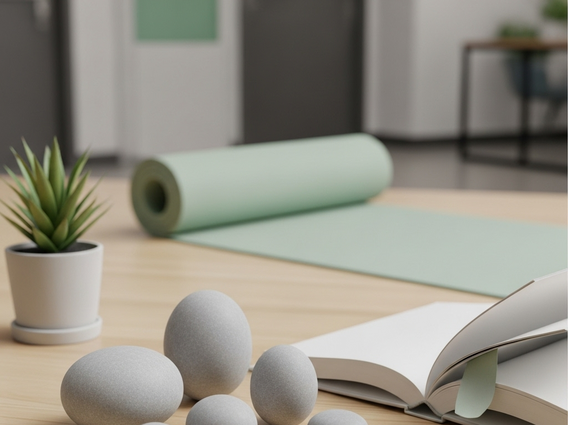Exercises to Ease Anxiety and Promote Calm
In our fast-paced world, finding effective strategies to manage stress and anxiety is more crucial than ever. This article explores various exercises to ease anxiety and promote calm, offering practical approaches to integrate physical activity and mindfulness into your daily routine for enhanced mental well-being.

Key Takeaways
- Exercise significantly reduces anxiety by releasing endorphins and reducing stress hormones.
- Gentle movements like yoga, walking, and Tai Chi are excellent calming exercises for anxiety.
- Mindfulness practices such as deep breathing and meditation offer immediate anxiety relief exercises at home.
- Short, accessible exercises can be integrated into busy schedules for quick stress reduction techniques for calm.
- Consistency is key to leveraging how to use exercise for anxiety for long-term benefits and sustained well-being.
Understanding How Exercises to Ease Anxiety and Promote Calm Work
The connection between physical activity and mental health is well-established. Engaging in exercises to ease anxiety and promote calm can significantly impact your emotional state, offering a natural and accessible pathway to greater tranquility. Understanding the mechanisms behind these benefits can empower you to choose the most effective strategies for your needs.
The Science Behind Calming Exercises for Anxiety
When you engage in physical activity, your body releases endorphins, natural mood elevators that can reduce feelings of pain and induce a sense of euphoria. Simultaneously, exercise helps to reduce the levels of stress hormones like cortisol and adrenaline. This biochemical shift is a primary reason why calming exercises for anxiety are so effective. Regular physical activity also improves sleep quality, which is often disrupted by anxiety, further contributing to a more stable and calm mental state.
- Endorphin Release: Natural mood boosters that alleviate stress.
- Hormone Regulation: Decreases cortisol and adrenaline, the body’s stress hormones.
- Neurotransmitter Balance: Can positively influence serotonin and norepinephrine levels.
- Improved Sleep: Contributes to better rest, a critical factor in anxiety management.
Why Exercise is a Key Stress Reduction Technique for Calm
Beyond the chemical changes, exercise serves as a powerful distraction from anxious thoughts. When you focus on your movements, breath, or the environment around you, it pulls your attention away from worries and rumination. This mental break is a vital stress reduction technique for calm, allowing your mind to reset and regain perspective. Furthermore, achieving fitness goals, no matter how small, can boost self-esteem and provide a sense of accomplishment, which are protective factors against anxiety.
How to Use Exercise for Anxiety Relief Effectively
To maximize the benefits of exercise for anxiety relief, it’s important to approach it strategically. Consistency is more important than intensity. Even short bursts of activity can make a difference. Finding an activity you enjoy is crucial, as this increases the likelihood of adherence. Consider incorporating a variety of exercises, from vigorous cardio to gentle mindfulness practices, to address different aspects of anxiety and stress. Learning how to use exercise for anxiety involves listening to your body and mind, adapting your routine as needed.
Gentle Movement Exercises to Ease Anxiety and Promote Calm
Not all effective exercises to ease anxiety require high intensity. Gentle movement practices can be incredibly potent for calming the nervous system and fostering a sense of peace. These activities often combine physical postures with mindful breathing, offering a holistic approach to stress reduction.
Yoga Poses as Relaxation Exercises for Anxiety
Yoga is a time-honored practice that blends physical postures, breathing techniques, and meditation. Many yoga poses are specifically designed to be relaxation exercises for anxiety, promoting flexibility, strength, and mental clarity. Poses like Child’s Pose, Legs-Up-the-Wall, and Savasana (Corpse Pose) are particularly effective for calming the mind and releasing tension from the body. The focus on breath in yoga helps to activate the parasympathetic nervous system, which is responsible for the body’s “rest and digest” response.
- Child’s Pose: Gentle stretch for the back, calms the brain.
- Legs-Up-the-Wall: Soothes the nervous system, reduces fatigue.
- Savasana (Corpse Pose): Promotes deep relaxation and mental quietness.
- Cat-Cow Pose: Gentle spinal movement linked with breath, releases tension.
Walking: A Simple Exercise to Ease Anxiety
Walking is perhaps the most accessible exercise to ease anxiety. It requires no special equipment and can be done almost anywhere. A brisk walk in nature, often called “forest bathing,” has been shown to significantly reduce stress hormones and improve mood. The rhythmic motion of walking can be meditative, providing a gentle distraction from anxious thoughts while offering the benefits of fresh air and natural light. Even a short 10-15 minute walk can make a noticeable difference in your anxiety levels.
Tai Chi for Promoting Calm and Reducing Stress
Tai Chi, an ancient Chinese martial art, is often described as “meditation in motion.” Its slow, deliberate movements, combined with deep breathing and mental focus, make it an excellent practice for promoting calm and reducing stress. Tai Chi improves balance, flexibility, and cardiovascular health, while also cultivating a sense of inner peace and mindfulness. Regular practice can help to regulate emotions and enhance overall mental resilience, making it a powerful tool among stress reduction techniques for calm.
Breathing and Mindfulness Exercises to Ease Anxiety and Promote Calm
Sometimes, the most powerful exercises to ease anxiety don’t involve vigorous movement at all. Breathing techniques and mindfulness practices are potent tools that can be utilized anywhere, anytime, to quickly shift your physiological and psychological state towards calm.
Deep Breathing: Best Exercises to Promote Calm
Deep breathing, particularly diaphragmatic or belly breathing, is one of the best exercises to promote calm because it directly influences your autonomic nervous system. By consciously slowing and deepening your breath, you signal to your body that it’s safe to relax. This counteracts the shallow, rapid breathing often associated with anxiety. Practicing deep breathing for just a few minutes can lower heart rate, reduce blood pressure, and bring a profound sense of tranquility.
Here’s a simple deep breathing exercise:
- Sit or lie comfortably.
- Place one hand on your chest and the other on your belly.
- Inhale slowly through your nose, feeling your belly rise.
- Exhale slowly through your mouth, feeling your belly fall.
- Repeat for 5-10 minutes, focusing solely on your breath.
Mindful Meditation for Anxiety Relief Exercises
Mindful meditation involves focusing on the present moment without judgment. This practice can be incredibly effective as one of the anxiety relief exercises, helping to detach from overwhelming thoughts and emotions. By observing your thoughts and feelings without getting caught up in them, you create a space for calm and clarity. Regular meditation practice can rewire the brain, reducing activity in the amygdala (the brain’s fear center) and increasing activity in areas associated with attention and emotional regulation.
Progressive Muscle Relaxation for Calming Anxiety
Progressive Muscle Relaxation (PMR) is a technique where you systematically tense and then relax different muscle groups in your body. This practice helps you to become more aware of physical sensations of tension and relaxation. By consciously releasing tension, you send a powerful signal to your brain to calm down. PMR is a highly effective method for calming anxiety, especially when physical tension is a prominent symptom. It can be done anywhere, making it a versatile tool for immediate relief.
Quick At-Home Exercises to Ease Anxiety and Promote Calm
Life can be hectic, but even short bursts of activity can be incredibly effective as exercises to ease anxiety and promote calm. These quick, accessible options are perfect for when you need immediate relief without leaving your home or office.
Instant Anxiety Relief Exercises at Home
When anxiety strikes suddenly, having a few instant anxiety relief exercises at home can be invaluable. These don’t require much space or time but can quickly shift your state. Jumping jacks, high knees, or even a quick dance to your favorite song can release pent-up energy and change your focus. The key is to engage your body in a way that disrupts the anxiety cycle and introduces a sense of control.
Short Stress Reduction Techniques for Calm
Incorporating short stress reduction techniques for calm throughout your day can prevent anxiety from building up. These might include a quick set of push-ups, squats, or lunges. Even a few minutes of vigorous activity can trigger the release of endorphins and help clear your head. Consider setting a timer for 5-10 minutes and dedicating that time entirely to movement, no matter how small.
Desk Stretches as Calming Exercises for Anxiety
For those who spend a lot of time sitting, desk stretches are excellent calming exercises for anxiety. They help release physical tension that often accompanies stress and can be done discreetly. Neck rolls, shoulder shrugs, wrist circles, and gentle spinal twists can improve circulation and reduce stiffness, offering a mental break and physical relief. These simple movements can prevent tension headaches and improve focus.
| Exercise | Duration | Primary Benefit | Accessibility |
|---|---|---|---|
| Deep Breathing | 2-5 minutes | Immediate calm, nervous system regulation | Anywhere, anytime |
| Desk Stretches | 3-5 minutes | Tension release, improved posture | At desk, no equipment |
| Jumping Jacks | 1-2 minutes | Energy release, mood boost | Small space, no equipment |
| Mindful Walking | 10-15 minutes | Mental clarity, stress reduction | Outdoors or indoors |
Integrating Daily Exercises to Ease Anxiety and Promote Calm
The true power of exercises to ease anxiety and promote calm lies in their consistent application. Making these practices a regular part of your routine can lead to sustained improvements in mental health and resilience against stress.
Making Exercise a Habit for Anxiety Relief
Building a consistent exercise habit for anxiety relief requires planning and commitment. Start small, perhaps with 10-15 minutes of activity daily, and gradually increase duration or intensity. Link your exercise to an existing habit, such as walking after dinner or doing stretches before your morning coffee. Setting realistic goals and celebrating small victories can help maintain motivation. Remember, the goal is not perfection, but consistent effort.
Finding Time for Best Exercises to Promote Calm
Finding time for the best exercises to promote calm can be challenging in a busy schedule. Prioritize your mental well-being by scheduling exercise just like any other important appointment. Break up longer workouts into shorter segments throughout the day if necessary. Even 5-minute bursts of activity can accumulate and provide significant benefits. Consider waking up a little earlier or using your lunch break for a quick walk or stretching session.
How to Use Exercise for Anxiety in Your Routine
Effectively integrating how to use exercise for anxiety into your routine involves tailoring it to your lifestyle and preferences. If you thrive on social interaction, join a group fitness class or find a walking buddy. If you prefer solitude, explore solo activities like running, yoga, or hiking. Experiment with different types of exercises to discover what resonates most with you. The more enjoyable the activity, the more likely you are to stick with it, making it a sustainable part of your anxiety management strategy.
Long-Term Benefits of Exercises to Ease Anxiety and Promote Calm
While exercises to ease anxiety and promote calm offer immediate relief, their most profound impact is often seen in the long term. Consistent engagement with physical activity and mindfulness practices builds resilience, improves overall health, and fosters a sustained sense of well-being.
Beyond Immediate Calm: Sustained Anxiety Relief Exercises
Regular engagement in sustained anxiety relief exercises can lead to structural and functional changes in the brain that enhance emotional regulation and stress tolerance. Over time, individuals often report a reduction in the frequency and intensity of anxiety symptoms, improved coping mechanisms, and a greater sense of control over their mental state. This cumulative effect transforms exercise from a temporary fix into a fundamental pillar of mental health maintenance.
- Enhanced Emotional Regulation: Better ability to manage and respond to stress.
- Increased Resilience: Improved capacity to bounce back from adversity.
- Reduced Baseline Anxiety: Lower general levels of anxiety over time.
- Improved Cognitive Function: Better focus, memory, and problem-solving skills.
Improving Sleep with Calming Exercises for Anxiety
One of the significant long-term benefits of regular calming exercises for anxiety is vastly improved sleep quality. Anxiety often interferes with sleep, creating a vicious cycle where poor sleep exacerbates anxiety. Exercise helps regulate your circadian rhythm, reduces the time it takes to fall asleep, and promotes deeper, more restorative sleep. However, avoid intense exercise too close to bedtime, as it can be stimulating; gentle activities like yoga or stretching are better choices in the evening.
Enhanced Well-being from Stress Reduction Techniques for Calm
Ultimately, consistent engagement with stress reduction techniques for calm contributes to an overall enhanced sense of well-being. This includes not just the absence of anxiety but also the presence of positive emotions, greater life satisfaction, and improved physical health. Exercise fosters a stronger mind-body connection, increasing self-awareness and promoting a holistic approach to health. It empowers individuals to take an active role in managing their mental health, leading to a more balanced and fulfilling life.
Frequently Asked Questions About Exercises for Anxiety
How quickly can exercises to ease anxiety start to work?
Many people experience immediate relief from anxiety symptoms after just a few minutes of exercise. The release of endorphins and the shift in focus can provide a quick mood boost and reduce feelings of tension. For example, a 10-minute brisk walk or a few minutes of deep breathing can significantly alleviate acute anxiety.
However, the most profound and lasting benefits come with consistent practice over time. Regular exercise builds resilience against stress and helps regulate mood more effectively in the long run.
Are there specific calming exercises for anxiety that are better than others?
The “best” calming exercises for anxiety are highly individual. What works well for one person might not be as effective for another. Generally, activities that combine physical movement with mindfulness, such as yoga, Tai Chi, or mindful walking, are often recommended due to their holistic benefits.
For some, vigorous aerobic exercise like running or cycling is most effective for burning off anxious energy, while others find gentle activities like stretching or deep breathing more soothing. The key is to find an activity you enjoy and can stick with consistently.
Can I do anxiety relief exercises at home without any equipment?
Absolutely! Many effective anxiety relief exercises can be done right at home with no special equipment. Bodyweight exercises like squats, push-ups, or planks are excellent for physical exertion. Deep breathing, meditation, and progressive muscle relaxation require nothing but your body and a quiet space.
Even simple activities like dancing to music, doing household chores vigorously, or taking a brisk walk around your neighborhood count as beneficial exercises. The accessibility of these options makes them powerful tools for managing anxiety on demand.
How much exercise is recommended for stress reduction techniques for calm?
General guidelines suggest at least 150 minutes of moderate-intensity aerobic activity or 75 minutes of vigorous-intensity aerobic activity per week, along with muscle-strengthening activities on two or more days. However, for stress reduction and calm, even smaller amounts can be beneficial.
Studies show that even 10-15 minutes of walking or light exercise can significantly reduce anxiety. The most important factor is consistency. Aim for regular, even short, bouts of activity throughout your week, rather than infrequent, intense sessions, to maximize the benefits for mental well-being.
How can I integrate how to use exercise for anxiety into a busy schedule?
Integrating exercise into a busy schedule requires creativity and prioritizing. Break down your exercise into smaller, manageable chunks throughout the day. For example, do 10 minutes of stretching in the morning, a 15-minute brisk walk during lunch, and another 10 minutes of light activity in the evening.
Utilize short breaks for quick desk stretches or deep breathing exercises. Schedule your workouts in advance and treat them as non-negotiable appointments. Even small bursts of movement add up and contribute to your overall mental health and calm.





